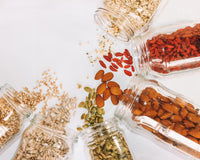The vegan lifestyle means a great deal more than just giving up meat. Those who make the switch may also find that their digestive processes will become greatly improved, their food budgets greatly reduced and their carbon footprint lessened.
Learn Your Spices
When you're breaking away from a meat-based diet, you will find that your ability to taste flavours that used to be your favourite will change. The fat content in meat can make many spices much more aromatic, and the flavour will be more easily delivered. When leaving meat behind, it may be easier to start fresh rather than trying to replace meat on your plate and in your favourite recipes. According to ChooseVeg, finding the proper seasonings can make all the difference between tolerating and loving your food. For example, the addition of dried mushrooms and plenty of garlic is a great way to add a distinctly vegan flavour to a broth. Adding red wine or miso to sauces and soups will create a depth of flavour that can be as satisfying as meat but with its own unique twist.
Find Transition Food
The fat and flesh of meat is a great vehicle for seasonings. Transition foods can provide you with flavour and texture satisfaction to help you break away from the desire for the flavours, fat and texture of meat. For example, roasting root vegetables, such as beets, for sweetness; turnips for a bitter bite; and sweet potatoes for a luscious, velvety texture can help you transition from meat. According to Sam’s Pizza, mushrooms provide a rich array of flavour varieties and have a vibrant and firm texture that mimics flesh and meat to help take the edge off of those cravings. Don't worry about meeting your protein needs. There are several beans and grains that, when combined, can easily satisfy your protein needs.
No More Trios
A standard meat-based diet is often structured around a plate divided into thirds that contains a protein, a starch and a vegetable. Instead, prepare yourself a vegan plate meal. A vegan plate consists of whole grains, legumes, vegetables and fruit. This provides protein, fibre and a wide variety of nutrients. It also keeps you from feeling like something is missing from your plate.
Eating a healthy diet loaded with vegetables, grains and legumes will require you to change your shopping, cooking and eating habits. It will also change your palate over time. Be ready to try new recipes and new cooking styles. For example, vegetables you used to dislike can taste completely different when slow-roasted. Many hearty vegetables that you've always cooked can be delicious when grated into a salad. New formats equal new flavours.
If you love vegan food, check out our awesome deals! We have everything you need to satisfy your stomach!






